2002 Prinsendam (II) Part III

Prinsendam Lecture Part II. 2002 until the end.

The name Prinsendam was heard for the first time in the 1930’s when near the end of the depression Holland America obtained funds to built a new ship. For the depression years this was a big happening as it brought much needed work to the depressed Ship bulding Industry. A complete mock up was built in the streets to draw attention to this glimmer of hope for those out of work. A new ship built in Holland which would bring a lot of work to the shipyards and the various sub contractors and those involved did not hesitate to announce that. The mockup had the name Prinsendam but in the end it was decided that the ship would be name Nieuw Amsterdam, after the original name of New York and the name Prinsendam remained dormant.

As mentioned in part 1, I think that it was not a coincidence that the Royal Viking Sun ended up being the same size as the ss Rotterdam of 1958 as the ship had a similar style of cruising with long voyages and a two public deck layout which the RVS would emulate.
When Holland America built the first Cruise – only ship for the company it decided to resurrect the dormant name of Prinsendam from 1936. This little ship had a number of novel things which would shape the cruise ships of Holland America for the near future and in some extent also that of the cruise industry. Especially the decision to create the “Holland America Line Swivel” which made it possible to reach each public room in the ship without having to go up and down the decks. This first Prinsendam sunk in 1980 and the name was once again retired.
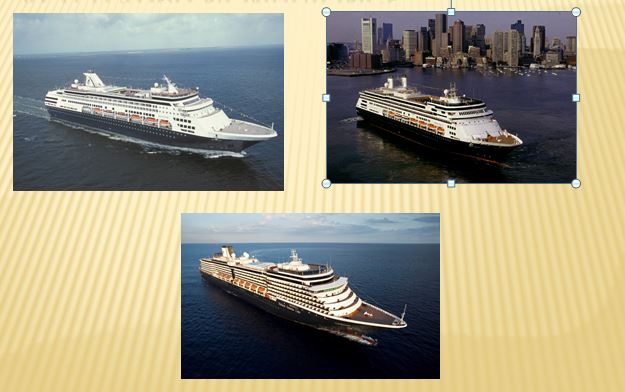
Carnival Corporation bought the Holland America Cruise Division in 1989 and that was the start of a big expansion of the fleet. Four S Class ships, Four R Class ships and then Four Vista Class Ships. When the Vista Class ships were in the planning, requests became louder for something smaller. Gests did not object to bigger ships (everybody wanted a balcony now) but they also wanted to visit ports which were out of reach of all these new ships.
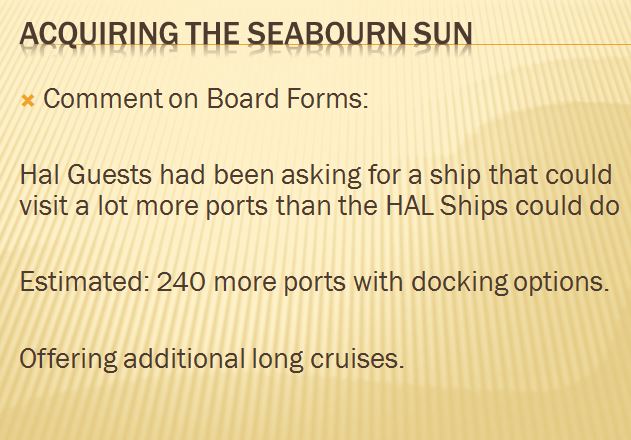
One of the strengths of Carnival Corp is, although they leave their brands alone, that the Brand CEO’s do talk to each other and share challenges and improvements they have made. Thus it was known in all the brands that Holland America needed a smaller ship for longer cruises and the Seabourn Sun was a bit of a white elephant in the Seabourn Fleet as it was soo much bigger than the other ships of that fleet.

On 23 March 2001 it was announced that the ship would be switched to the HAL with a delivery in April 2002 after the completion of a final world cruise for Seabourn.

Hal took over the ship on 23 April 2002 (Registration for Holland America Line, Antilles N.V. Rotterdam) and sent it for a conversion dry-dock to Detyens International shipyard in Charleston, NC.
Same as with our N ships in the 1980’s and many other cruise ships, the Royal Viking Sun had been built with only passive fire protection. In those years it was thought that by using by the new fire retardant materials that extra measures such as sprinkler were not needed any longer. Legislation, also helped by the Prinsendam (1) disaster, changed all this. Thus when the Seabourn Sun came over, The Dutch Flag State rightly demanded the retro fitting of a sprinkler system. Total refurbishment cost was in the region of US 22.5 mln.

The work included adding 14 Lanai State rooms by removing one public room (the Midnight Sun Lounge), reducing the dining room area which was made smaller as ship went from one seating to two. In the now open space came the Ocean Bar and the Odyssey Specialty Restaurant. (Later named the Pinnacle Restaurant) The ships capacity rose to 780 beds due to the new cabins.

Further additions were a Neptune lounge for the Suite guests, made possible by removing two officer cabins, an Internet cafe, an Art Centre and as mentioned before a new Sprinkler fire fighting system throughout the whole ship.

Most rooms remained the same, including the Stella Polaris Room but it was renamed to Crowsnest. In this room there had been model of the ss Stella Polaris which was one of the earliest luxurious cruise ships sailing in the Norwegian fjords. The model was removed to the Neptune Lounge and remained there until 2019. With the sale to the new owner there are plans to send the model to Seattle.

The Neptune Lounge for the Prinsendam was off a totally different design than for the other ships as the space available was much smaller. It was decided t re-create an “old Dutch” home interior.

A lot of work needed to be done to the outside decks where the wood work and underlying steel plating was in not all to great a shape.

Same for the cooking areas. (See here the Starboard side of the Lido Restaurant) where all the equipment was renewed and the layout optimised for the Holland America Line Lido Style.

The biggest changes where in the public rooms layout. Royal Viking had operated a 19.30 hrs. single sitting dinner operation and Seabourn had used open sitting operation. Holland America had as standard a two sitting operation and thus could the dining room be reduced in size. And that gave space for an Ocean Bar and an specialty Restaurant. Royal Viking had a cocktail area, one deck up (connected by a staircase down to the dining room) which now became the Explorers Lounge.

Addition of the Ocean Bar on deck 7 and the Lanai Cabins on deck 8 aft.

The Lanai cabins turned out to be only a partial success. The side cabins where well appreciated but the centre cabins with their enclosed deck space much less appreciated as guests could walk by and look inside. This was changed in 2010 when more cabins were added.

The extra balcony cabins were an addition which did not stand out too much from the ships original super structure as on deck 9, 10 and 11 there were balcony cabins as well.
 What was a major change to the interior was the change from Compass Rose cocktail room from Royal Viking days to the Explorers Lounge of Holland America. In Royal Viking days this was a main pre dinner cocktail area but that function was now taken over by the Ocean Bar. Holland America needed another after dinner entertainment venue, for light classical music.
What was a major change to the interior was the change from Compass Rose cocktail room from Royal Viking days to the Explorers Lounge of Holland America. In Royal Viking days this was a main pre dinner cocktail area but that function was now taken over by the Ocean Bar. Holland America needed another after dinner entertainment venue, for light classical music.

In the Atrium , additional art was installed with photos/impression of tulip fields and a two story high Glass sculpture depicting Sea life from Sea floor to the surface.

The Specialty Restaurant appeared for the first time with the arrival of the Rotterdam (VI) and then the older ships were retrofitted and all the new ships got them as well. Thus when the Prinsendam came into being an Odyssey Restaurant was added as well.

In the few years of sailing as the Seabourn Sun there had not been much maintenance carried out on the cabins and thus time and effort wa spent on this as well. The cabins and bathrooms would remain an point of attention for several years until all the cabins had received the Holland America house style.

During the refit the ships flag was changed from the Bahamas to the Dutch Flag. In the picture Chief Officer Andre van Schoonhoven and the Ships Bo’sun. The Dutch flag should have been the same size as the Bahama one but stores and spare parts do not always arrive in the time and sequence the ship has ordered them or expects them.

As a final change the deck names were brought into line with the Holland America naming system.

The ship sailed from Charleston to New York empty. While on the coastal the ship was cleaned from top to bottom for the christening/ dedication in New York. The ship was visited to by large numbers of travel agents and was christened by three HAL employees as representatives of all the HAL employees (approx. 8000). New York City Mayor Michael Bloomberg issued an official proclamation naming Monday, June 3, 2002, “Prinsendam Day.” (Which was something that had also happened when the ss Rotterdam arrived on her maiden voyage in 1959. The first cruise was a gala 10-day transatlantic crossing, departed New York for Southampton (Engand) on June 3. It was Big Band theme cruise, featuring Guy Lombardo’s Royal Canadians and the ship called at Halifax, (Nova Scotia) Cork (Ireland) and Plymouth (England)
Then regular cruises to the Baltic. followed by an Alaska Season in 2003.
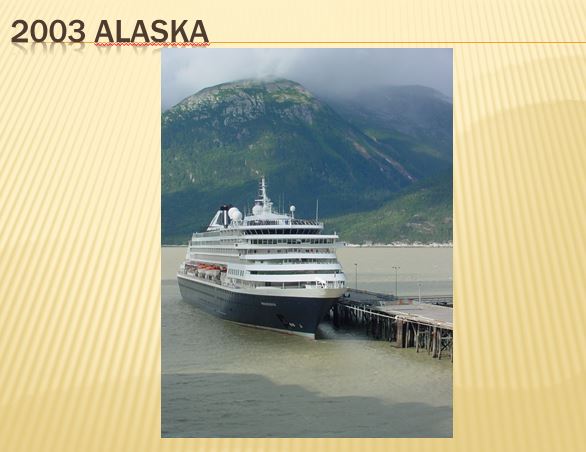
This is the ms Prinsendam docked in Skagway, Alaska in 2003.
The ship only came to Alaska only for one year as all the ports could be reached by larger ships so she was better of to conduct other cruises. Also the Prinsendam did not have that much maneuvering power in the stern and that could be challenging for windy days and tugboat availability was limited. Thus the ship sailed in Europe in the subsequent years in the summer and to the smaller ports.

By 2007 the company had two ships which stood out for their long cruises and loyal following. The ms Amsterdam (III) which had taken over the worldcruise routine from the Prinsendam (II) and the ms Prinsendam which was now making two Grand Voyages a year. This photo shows them meeting up during the RTDM world voyage and the PRDM grand mediteranean voyage.

In 2007 the company decided on a 30 day upgrade dry dock in the Bahamas. The company was upgrading all their ships under the SOE or Signature of Excellence Program and the Prinsendam II was part of this. Between 24 November and 15 December 2007, US 20 mln. was spent on new bathrooms in all the cabins, closet space, cabin furniture, a new explorations café, expansion of the shopping promenade and new soft goods for all the cabins. A larger library was installed as well. Together with the delivery of the last soft furnishings, the project was completed on 16 Jan. 2008.

A new Stuyvesant Room was created to serve as a meeting room with the option to act as a play space for Club Hal. This area used to be in use as a Golf Simulator from the Royal Viking days but the number of “golfing” guests with HAL was much less than with RVL and Seabourn. But there was need for a special meeting room for incentive groups and who needed an dedicated location for themselves.

The ship then continued on her far flung cruises and can be seen here on the buoys of Greenwich, London. This was always a three day visit as the ship had to go up the Thames with the high tide, then stayed on the moorings for the visit, and had to down the river again on the high tide. These calls were later changed to Tilbury down river, which location was not so scenic but provided much better service to the guests as the Greenwich location.

On 22 July 2009 the addition of 22 cabins on the stern of the ship (deck 8) was announced. They were to be installed during the next dry dock in the Bahamas from 04 to 14 Jan. 2010.

For this purpose the lanai cabins in the middle of the aft ship were removed as they had given lots of complaints due to the lack of privacy. A pre fabricated steel section was hoisted on board and welded in place. But only the steel construction was completed on departure from the yard on 13 Jan. and the interior was finished during the 70 day Grand Voyage around South America and Antarctica.

While the ship sailed from Fort Lauderdale to Valparaiso, construction workers remained on board to finish the cabins. The materials were stored in containers on the forward deck which gave in the subsequent ports of call the question if Holland America had branched out into the container business..

Cabins were ready on 4 February and the first paying guests came on board that day during the call at Valparaiso. The deck above the cabins was widened with the addition of a new outside bar. (was really an old bar as it had been transferred from the Rotterdam VI whose whole Lido deck was also revamped under the SOE program.) Guest Capacity now rose to 835 max. in 419 cabins, and the ships tonnage increased to: 37,983 brt. With the widening of the deck the ship finally lost the problem of the swimming pool water gushing over the edge to the deck below when the ship was moving. Other upgrades included a revamp of the Fitness area adjacent to the enlarged outside deck with a larger exercise room and remodeled treatment rooms.

As the cabins were put in the location where once was the Midnight Sun Lounge located, the glass elevator staircase boundary became once again visible. To make the walls less bare, the captain oat the time, Albert Schoonderbeek, installed HAL posters coming from his own collection. (The new owner Phoenix Reisen has indicated that they want to keep this HAL memorabilia in place)

Once completed the ship had now a much more square stern than before. The designer advised that making the area more “rounded” would have added substantial costs; well into the 6 figures, and hence it was decided not to do this. However the capacity increase ensured that the ship would remain profitable for years to come.
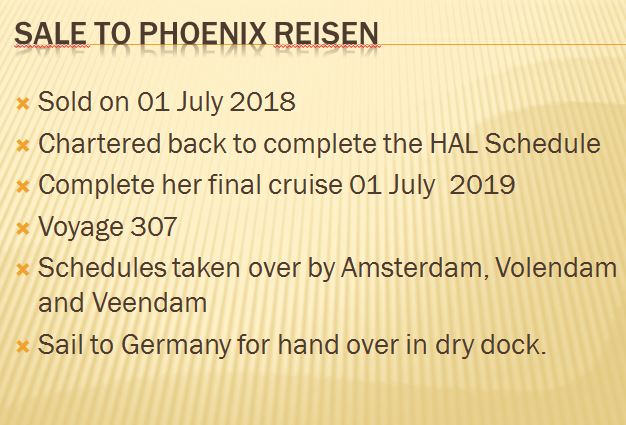
And so she did. But the Prinsendam was getting older and then a decision has to be made to: either make another in depth investment or to retire the ship from the fleet. It was decided to go for a sale as there was interest from Germany. Phoenix Reisen of Germany is a company which is specialized in operating older ships and its clientele enjoys ships which have some history. At the moment of purchase the Phoenix Fleet consisted out of:
ms Albatross ex Royal Viking Sea (Royal Viking Lines) built 1973
ms Amadea ex Asuka (Nippon Yusen Kaisha) built 1991
ms Artania ex Royal Princess (Princess) built 1984
ms Deutschland ex Deutschland (Deilman) built 1998
Thus with the Prinsendam now going to Phoenix she would meet up again with an old Fleet mate. The ship was sold on 1 July 2018 and then with a bare boat chartered taken back for 365 days to carry the cruises which were already booked. The final cruise took place between 17 June and 01 July. From Amsterdam to the North Cape and back again. In Amsterdam all guests disembarked and also a larger number of the cruise. The ship then sailed to Hamburg for dry docking and while in the dry dock it was handed over on 03 July. She is scheduled to re-emerge as the Amera on 20 August 2019. And if the cruise brochure is correct she will then basically carry on with the same cruises which the ms Prinsendam II made.
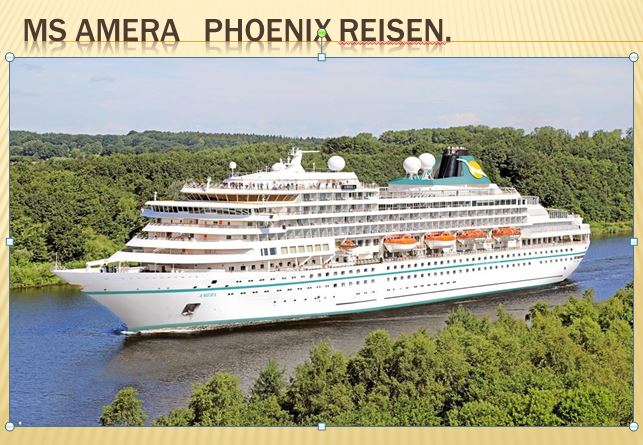
For those who want to relive the last voyage of the ms Prinsendam please go to the blog section and look at the dates 17 June to 30 June 2019.
